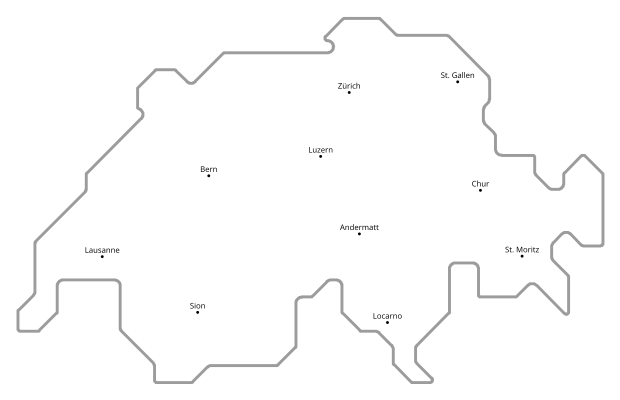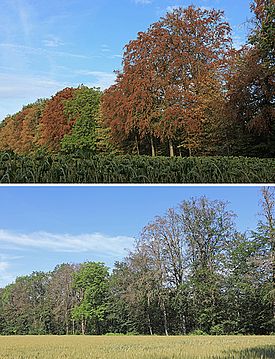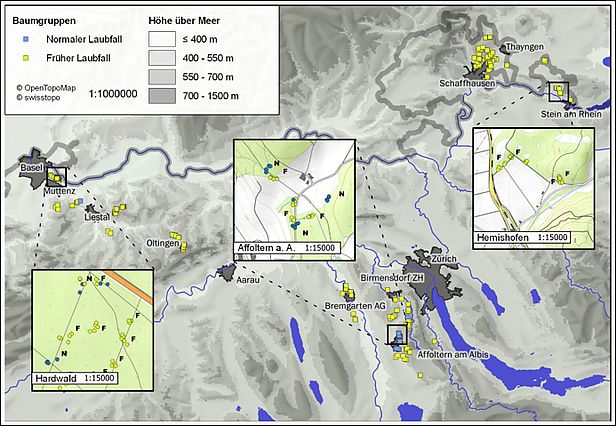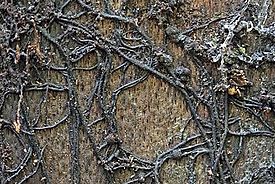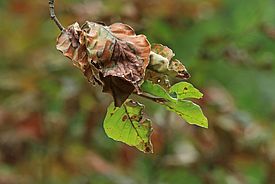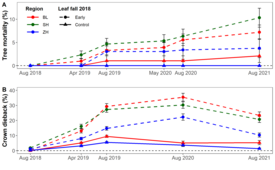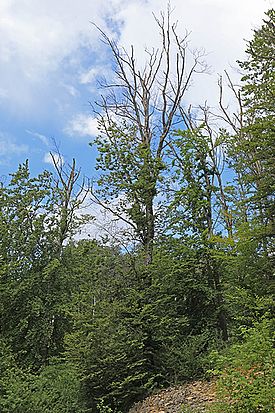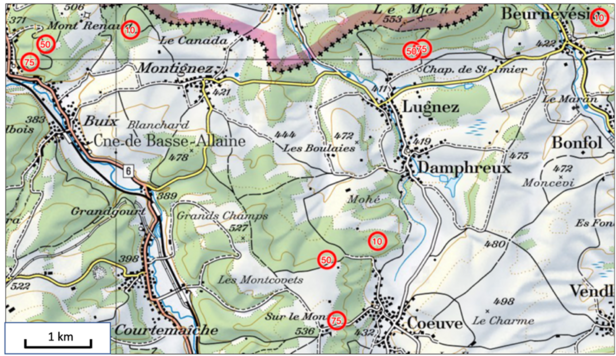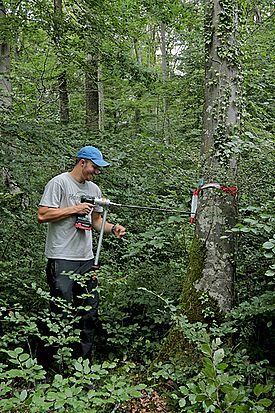Drought & beech: medium-term effects of the 2018 summer drought on beech north of the Alps
Arthur Gessler
Martin Gossner
Frank Hagedorn
Valentin Queloz
Andreas Rigling
Yann Vitasse
Georg von Arx
Ulrich Wasem
Katrin Di Bella Meusburger
Vivanne Dubach
Anne Verstege
Christian Ginzler
Stefan Klesse
Anna Neycken
Mathieu Lévesque
2020 - 2022
Cooperation FinancingThe extreme 2018 summer drought induced premature leaf senescence in beech as early as July in various parts of the Swiss Plateau and Jura. In this project, we investigate possible causes of this phenomenon, in particular soil properties and the damage due to previous drought periods. Furthermore, the tree vitality will be monitored during several years from 2018 on.
In Switzerland, as in many other regions of Europe, the summer of 2018 was marked by a heatwave accompanied by several weeks of drought. For example, some areas of the Swiss Plateau received only about two-thirds of the usual amount of rain. The severe drought led to premature leaf senescence, i.e., discoloration of beech foliage in various regions of Switzerland, followed by defoliation beginning in July and August (Fig. 1). This raised the question of whether the early defoliation is a defense strategy that provides beech trees with a physiological advantage, or whether it is a clear sign of weakness. In addition, we are interested in whether and how the beech trees recover from the drought in the following years.
As part of the WSL Drought 2018 initiative, the project "1000 beech trees" was launched to investigate whether the damage pattern of beech trees with early leaf senescence in 2018 differ in subsequent years from those trees showing a normal timing of leaf senescence, i.e., around October. In total, 964 beech trees were marked and drought damage was assessed in the regions of Baselland, Schaffhausen, Bremgarten (canton of Aargau) and western canton of Zurich The same trees were re-examined in the summers of 2019 and 2020. Several WSL research groups are collaborating on the project (Disturbance Ecology, Ecophysiology, Swiss Forest Protection, Forest Entomology, Soil Functions and Soil Protection).
The follow-up project "Drought and beech" was launched in spring 2020 and includes two modules: "1000 beech trees" and "Ajoie".
Module 1: 1000 beech trees
In this first module, the time series with 2018 and 2019 data on dead or recovering beech trees from the "1000 beech trees" project is extended by two more years. Furthermore, the project is complemented by tree-ring analysis in order to examine the medium-term effects of drought and the causes of different types of damage. The field surveys will show if and how well the trees can recover and how many will die.
The following research questions will be examined: How many beech trees with premature leaf senescence will survive until 2021? What damage did the trees suffer in the first four years? Does this damage depend on the characteristics of the soil, or is it caused by pests or pathogens?
Methods
The vitality (crown condition, total mortality) of all these trees was assessed again in 2019, 2020 and 2021.
In addition, side effects of biotic origin such as bark exudation, fungal infections and insect infestations on the stems (Figure 3) that might be late effects of the 2018 summer drought were recorded on all trees.
In July 2019 and 2020, leaf samples (Figure 4) were collected from a subsample trees for chemical analyzes and to insect herbivore damage. A soil study was also conducted on all sites.
From September to November 2020, cores were sampled from all beech trees in order to reconstruct the growth history of each tree using tree ring analysis and to check whether trees seriously affected by the drought of 2018 had not already been weakened by previous droughts.
Results
The surveys showed that of the beech trees selected in 2018, 4.4% died over the course of four years (Figure 5 a). Of the beech trees with premature leaf fall, about 10% died in the region of Schaffhausen, about 7% in the region of Baselland, and about 4% in the region of Zurich. Beech trees that lost their foliage at the normal time in 2018 showed significantly lower mortality; 2% in Baselland, while all survived in the region of Zurich in 2021. In addition to dead trees, 21% of the observed beech trees were cut and harvested during the study - mostly for safety reasons. In the second year after the summer drought (2020), the proportion of dead branches in the crown reached a peak of 25% of the crown volume (Figure 5b). Thereafter, the dead branch percentage decreased slightly again as new branches grew back. This observation could be an indication of an - at least temporary - recovery.
The evaluation of the different influencing variables shows that beech trees at sites with a drier climate and those trees with premature leaf fall showed more pronounced crown damage in 2018. In addition, larger trees were more damaged on average. The proportion of beech trees that exhibited bark lesions with fresh slime flow reached a maximum of 22.1% affected stems in 2019. In 2021, bark beetle boreholes were found on 21.5% of beech trees. These two secondary pests also occurred more frequently on trees with early leaf discoloration or premature leaf fall and were often also associated with higher crown mortality.
The research shows that premature leaf discoloration during the drought summer of 2018 was a symptom of weakness in a majority of the beech trees studied. The extreme lack of water triggered a progressive damage process, especially on sites with dry climates and shallow soils, which in some cases led to the death of the tree. Often, the increased crown mortality of beech has been accompanied by insect and disease infestations. The degree to which this secondary infestation further weakens the trees could not be clarified in this study. The drought of the past years was extremely exceptional for the growth of beech trees in the lowlands of Switzerland: After the period 2014 - 2018 already belonged to the driest phases of the last 250 years, the extreme drought of 2018 was followed by further, although not quite as extreme, droughts in the two following years. That beech trees suffered from intensified drought stress as a result is shown by other studies that observed a decline in tree ring widths in response to drought.
The intensity of the climatic drought, i.e. the perennial precipitation deficit in the summer half-year, determined the degree of damage at the regional level: in the north of Switzerland with less precipitation, the damage was greater than in the region of Zurich. The precipitation deficit was superimposed by local and small-scale differences in soil, tree and stand properties. This resulted in small-scale damage patterns with severely damaged beech trees on shallow soils in the neighborhood of hardly damaged trees on deeper soils. The regrowth of crown tissue, particularly the formation of glue trees, in the years following the drought indicates a partial recovery of beech. However, for now, it is not clear whether this is sustainable or temporary. Ultimately, beech resilience may increase over the long term through adaptation.
It remains unknown whether the pre-damaged trees will be even more susceptible to damage in a renewed drought phase, as has been put forward for discussion in an international study. Since an increased occurrence of dry periods and heat waves is to be expected in the course of climate change, a long-term decline or failure of beech trees that cannot recover from repeated droughts must be expected on the dry sites in northern Switzerland.
Module 2: Ajoie
The extreme 2018 drought caused significant and widespread damage to the beech forests of the Ajoie region (canton of Jura; figure 6). In this region, damage levels vary on a relatively small scale, sometimes even within a stand.
Therefore, this second module focuses on the predisposing factors that may explain the observed small-scale differences in drought-induced damage of beech stands. As predisposing factors, the local climate, soil properties and genetic factors will be examined.
In addition, long-term growth patterns in tree-rings will be analyzed to investigate whether past stresses (e.g., droughts or pests) have already weakened the beech trees.
Methods
In collaboration with the Office for the Environment of the canton of Jura, nine more than a 100 year old beech stands with different proportions of severely damaged beech trees were selected in early 2020, i.e. three stands each with a proportion of > 75%, 50% and 10% of damaged beech trees (figure 7).
In collaboration with the Institute of Applied Plant Physiology (IAP) and Swiss Forest Protection (WSL), 21 beech trees were selected and marked within each stand in spring 2020, i.e. 189 trees in total.
During summer 2020, two cores were collected from each tree (Figure 8) in order to reconstruct their growth history. With this approach, we expect to see that the trees most severely affected by the 2018 drought are those that had previously been weakened by droughts, resulting in narrower rings. Crown mortality of the beech trees was estimated by the proportion of dead branches and the crown transparency.
In fall 2020, soil pits were dug in all nine stands. Soil depth and other parameters were measured. Based on these data, a soil water balance model will be calculated for each stand to show possible differences in water balance between stands.
Results
Crown damage strongly depended on general soil water availability: in stands on very shallow or stony soils, trees had significantly more crown damage compared to stands on deep soils. The annual growth increment of all sampled stands highly depended on the water balance in a given year (for example, August 2017 to July 2018). A wide growth ring occurs when a lot of rain falls during this period. Annual rings varied more among beech trees on shallow soils, which rely on short-term plant available water for growth, than among trees on deep soils, because in these deep soils more water can be stored for a longer period of time at such sites. Within stands, smaller and slower-growing trees tended to be more damaged.
These results demonstrate that trees that were already growing in a weaker social status before the extreme summer of 2018 coped significantly worse with the extreme drought and heat than dominant and therefore more vigorous trees, and that beech stands on deep soils had sufficient water reserves to cope well through this dry and hot period. In a future with even more heat waves, beech will thus face increased problems on dry sites, and even on sites that are well supplied with water today, it could become difficult for beech.
Drought and beech: How do beech trees in Switzerland react to extreme drought?
Follow the project team during field work in summer 2020.
Publications
Other Publications
Klesse, S.; Meusburger, K.; Wohlgemuth, T.; Frei, E.R., 2022: Buchensterben hängt von Boden und Baumgrösse ab. Wald und Holz, 103, 8: 22.
Klesse, S.; Meusburger, K.; Wohlgemuth, T.; Frei, E.R., 2022: La mortalité du hêtre dépend de sa taille et du sol. Forêt 103, 8: 22.
